22 February, 2002
ELECTRIC MATH !
Tom Curran is the Palmer Station electrician. Tom is from
Burlington, Vermont, where he is a member of the International Brotherhood
of Electrical Workers, Local 300. Tom is a licensed electrician with over
twenty years experience.
This is Tom's first season on the ice. The summer season is a time for
maintenance and repair of things having to do with electricity. New
construction is done during the winter season, when fewer people are here.
Tom says that math comes into play with an electrician's first license. An
electrician uses math all the time. He or she needs to know geometry in
order to make angle measurements for bending conduit. An electrician needs
to know how to use equations. For example, it is important to know Ohm's
Law. Then an electrician can use it to calculate amperes, horsepower, and
kilowatts. An electrician also has to be able to read tables and graphs.
The electrician here at Palmer Station also needs to be ingenious. He has
to be able to solve many kinds of problems. As Tom said, "You can't just
run out to a hardware store if you need a switch and you don't have it!
Tom gave me some math problems. Here they are:
Ohm's Law states that "the rate of the flow of the current is equal to
electromotive force divided by resistance.
Electromotive force = volts=E
Current = amperes = I
Resistance = Ohms = R
Watts = P
1) Amperes (I) = Volts (E) divided by Ohms (R)
So, when Volts and Ohms are known, use I = E divided by R
Find the current of a 120 volt circuit with a resistance of 60 Ohms
2) Amperes(I) = watts (P) divided by volts ( E)
When watts and volts are known, use I = P divided by E
A 120 volt circuit has a 1440 watt load. Determine the current (amperes).
3) To find kilowatts in direct current, use this formula:
Kilowatts = volts times amperes divided by 1000
A 120 volt (DC) motor draws a current of 40 amperes. Determine the
kilowatts.
4) Tom is putting conductors in a metal box. He wants to use Number 18
wire. According to the National Electric Code, he needs a metal box with a
capacity of 30.3 cubic inches in order to place the number of conductors he
wants to use. Which of the following box dimensions would be appropriate
for this job?
A box 4 inches by 4 inches by 1 ¼ inches.
A box 4 inches diameter by 1 ¼ inches deep.
A box 4 inches by four inches by 2 1/8 inches.

Tom Curran enjoys a cup of tea on HMS Endurance. Several people from the station were invited out to tour this British ship when it was visiting Palmer. (see the journal for January 17, 2002)

Tom demonstrates the importance of understanding angle measurement. This device will assist in bending conduit to the proper angle.
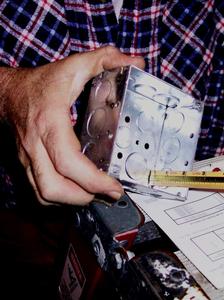
This is a close-up of Tom making a measurement of a metal box, to be sure of its capacity.

Tom Curran in the electrician's shop.

Tom Curran is in his office/shop. He is showing how measurement is an important part of his job. He is measuring the dimensions of a metal box in which conductors will be placed.
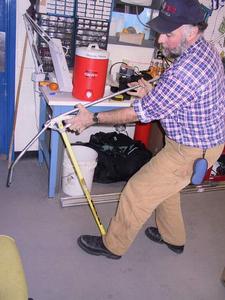
Tom bends the conduit to the proper angle for its use.
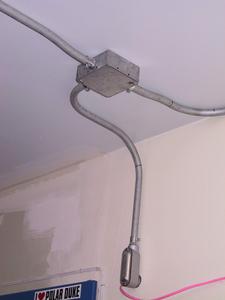
This is an example of how conduit must be bent in order to serve its purpose of carrying electrical wires safely to their destinations.
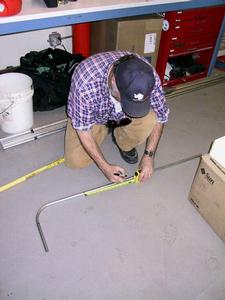
Tom has already bent a portion of the conduit at a 90 degree angle. He is making another measurement before making an additional bend in the conduit. You can see that measurement skills and knowledge of geometry are important to his job.
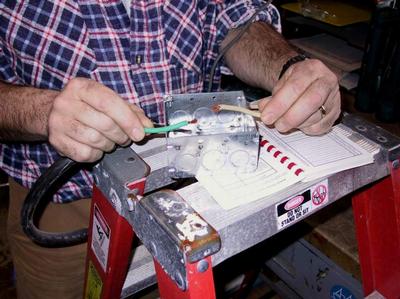
Tom shows why it is important to have the correct size metal box into which the wires will go.
Contact the TEA in the field at
.
If you cannot connect through your browser, copy the
TEA's e-mail address in the "To:" line of
your favorite e-mail package.
|
